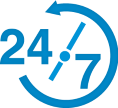About iSafeguard™
Based on past experieces, this new generation of iSafeguard™ came to life with the following goals, considerations and design decisions.
The Primary Goal
The primary goal is to enable data owners to take control of their data, no matter where the data resides, be it on a local storage or a cloud storage. Specifically the goal includes the following three aspects:

Enables a data owner to backup data securely such that the backup data is a black box to anyone except for the data owner, both the contents and metadata of the orignal data are encrypted.

Enables a data owner to share data with others securely. The data owner determines who is allowed to access data, and can change or revoke their access at any time. In addition the data is secure end to end.

Enables a data owner, and data recipients if the data is shared, to sync data between the local copy of the data and the backup data, and across different computers. Again if the data is shared it is secure end to end.
Data Security Considerations
Now let's take a look at the data security considerations. People who are familiar with the data security principles know that data security includes data confidentiality, data integrity and data availability. Here is what we do to support our primary goal described above applying the data security principles:

It means only authorized people have access to data. This is achieved by using encryption and a distributed access control system.

It means only authorized people can change or update data. If, for example, data is changed by unauthorized people, the changes are detectable. This is achieved by using digital signature.

It means data must be available whenever and wherever it is needed. We explain our decision and reasons below.
Data availability is critical because data is useless if it is not available, no matter how secure it is. This requires an IT infrastructure that is multi-site high-availability (MSHA). We don't believe that we can do better than Google, Microsoft, Amazon, or other well known vendors in this area, and we don't want our users to have another account to manage either. Therefore we decided not to host user data, instead we use their existing online accounts to store their own data.
Additional Data Security Considerations
Additional data security considerations include:
- Data must be secure even when a user's online account is hacked. That means the hacker can neither get the contents nor the metadata of the original data.
- If data is shared with others the security must be end to end. That means data is encrypted before leaving your computer, and remains encrypted at rest, and in transit; it is decrypted only when it reaches the computer of a recipient, with the private key of the recipient.
- Data access control must be distributed. That means even if one account is compromised it will not affect any other accounts.
Lastly only the well-known industrial standards, such as AES, SHA256, SHA512, RSA, etc. are used.
Easy to Use UI and Good UX
Public key cryptography is used in the encryption of data and metadata. As people familiar with public key cryptography know, encryption and decryption are not symmetric, unlike shared secret cryptography (or symmetric key cryptography).
This asymmetric nature creates a lot of confusion for people who are not familar with it. We have first hand experiences with our previous versions of iSafeguard.
In this new generation we strive to make it easy to use. We believe we achieved most of our initial design goals to simplify users' interaction with the software, while leaving the hard and tedious work behind the scene. Still there are many places we can improve and would love to hear your feedback. Please send your sugguestions, questions and comments to help@isafeguard.com.